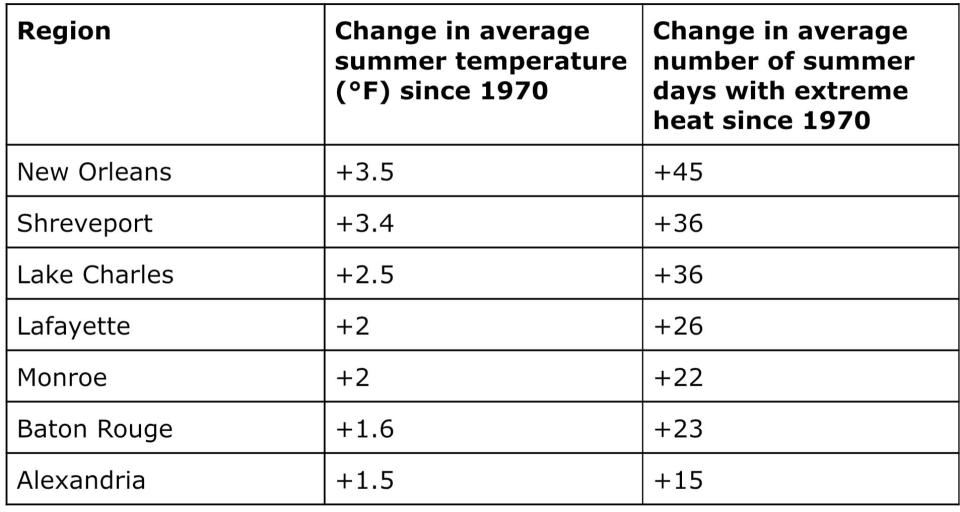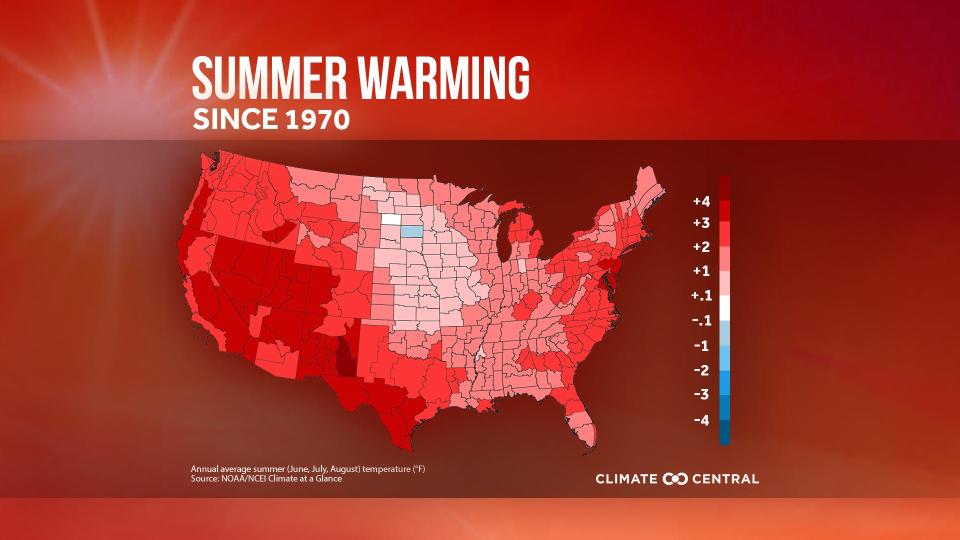Expect to see more days of extreme heat in Lafayette this summer. Here's why.
Summers in Lafayette are getting hotter and the number of days with extreme heat is increasing, making vulnerable populations more prone to heat-related illnesses and outdoor work more difficult.
The average summer temperature in Lafayette has risen by 2 degrees Fahrenheit since 1970, according to Climate Central. The number of summer days with extreme heat has increased by 26 days over the same period.
Though 2 degrees may not sound significant, seemingly small changes in average temperatures makes days with extreme heat much more prevalent, Climate Central meteorologist Megan Martin explained.
“The entire curve shifts towards these warmer temperatures, which means a big jump in the number of extremely hot days,” Martin said. “These are the extremes that we would actually notice more. They impact us the most and they have a lot of consequences for us, especially when it comes to our health.”

Other consequences include longer mosquito seasons, air stagnation that negatively impacts air quality and increased demand on cooling systems, which means higher costs, Martin said.
Summer temperatures have been rising in most of the U.S., especially in the West in Southwest. And although Acadiana is feeling the heat, other parts of Louisiana have seen more significant increases.

Summers in New Orleans are 3.5 degrees Fahrenheit warmer, and the number of days with extreme heat has increased by 45. Shreveport has seen similar changes.
The prevalence of humidity in the South may increase too as the planet warms.
“As the atmosphere warms, it's able to hold more moisture,” Martin said. “There is more opportunity for humidity in the air.”
Since the Industrial Revolution, the burning of fossil fuels like coal, oil and gas has been releasing carbon dioxide, a greenhouse gas that traps heat in the Earth’s atmosphere, leading to warming of the planet. The planet has warmed by nearly 2 degrees Fahrenheit since 1880, according to NASA.
Increased health risks for low-income, homeless populations
Though it’s difficult to accurately determine heat-related deaths, higher temperatures and more days with extreme heat mean more health risks, especially for vulnerable populations.
Climate Task Force: ‘A generational opportunity’: State climate task force sets eyes on federal money
Ben Broussard, chief of external affairs for Catholic Charities of Acadiana, said their organization deals first hand with the effects of summer heat on low-income households and the homeless in Acadiana.
“Heatstroke is very common, especially people with compromised immune systems and people who have been in a chronic experience of homelessness,” Broussard said. “It's just too hot, often too hot to just be outside all the time.”
Exposure to extreme heat and humidity makes it difficult for our bodies to cool off, which can lead to heat-related illnesses like heat cramps, heat exhaustion and potentially strokes.
Infants and children, athletes, adults over 65, outdoor workers, low-income households and people with chronic medical conditions are most vulnerable to heat-related illnesses, according to The Centers for Disease Control and Prevention.
Broussard said low-income households with poor insulation is a big issue.
“They're running their air conditioner all day long in a home that is not weatherized,” he said. “And so the stress for them is, ‘Am I going to be able to afford this?’”
Preparing for hurrican season: Lafayette Utilities met with state's power providers to coordinate ahead of hurricane season
Power outages caused by hurricanes or other natural disasters is another concern for southern Louisianans. The Louisiana Department of Health reported that 12 of the 28 deaths caused by Hurricane Ida in 2021 were heat-related.
Lafayette is also considered an "urban heat island," a developed area that is warmer than its surroundings due to reflective surfaces, paved roads and parking lots that absorb and reflect heat into the surroundings.
More developed parts of Lafayette can be nearly 7 degrees Fahrenheit warmer than their surroundings, according to Climate Central. New Orleans is the hottest urban heat island in the country, with the city being 9 degrees Fahrenheit warmer than the outskirts.
To stay cool this summer and avoid heat-related illness, the Centers for Disease Control and Prevention recommends wearing lightweight, light-colored clothing; staying indoors with air conditioning if possible; limiting outdoor activity; wearing sunscreen and drinking plenty of fluids to stay hydrated.
This article originally appeared on Lafayette Daily Advertiser: Lafayette weather is getting hotter this summer, increasing heat risk

